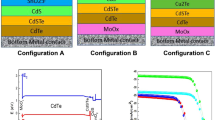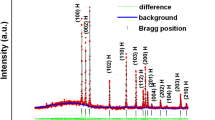Abstract
Photoconductive CdS (PC-CdS) in CdS/CdTe solar cells from five different sources is investigated using spectral sensitization of apparent quantum efficiency (AQE) and J-V analysis. Red bias light significantly enhances the blue AQE, commonly leading to AQE>1 below 550 nm, and blue bias light enhances the red AQE, but to a much smaller extent. These enhancements are more pronounced with increasing forward bias, after stress and in devices with intentionally Cu-doped CdS. This behavior is observed to some degree in all devices with CdS, but is absent in cells without CdS. These effects are consistent with blue light, either ac monochromatic or dc bias, increasing the CdS conductivity. This causes an increase in the field and depletion width in the CdTe to maintain balanced space charge, leading to increased collection of carriers from the CdTe. The CdS conductivity modulation can also change the AQE due to a change in equivalent circuit resistance. Analysis of J-V data measured with white, blue, red or no light indicates little dependence of series resistance or diode quality factor on the illumination spectrum. Thus, the PC-CdS resistance has little effect on the solar cell J-V performance, but does influence AQE.
Similar content being viewed by others
References
A. Rothwarf, Solar Cells 2, 115–1140 (1980).
A. Fahrenbruch, R. Bube, “Fundamental of Solar Cells”, Academic Press, New York Chapter 10 (1983).
S. Asher, F. Hassoon, T. Gessert, M. Young, P. Sheldon, J. Hiltner, J. Sites, Proc. 28th IEEE Photovoltaic Spec. Conf., 478–482 (2000).
I. Visoly-Fisher, K. D. Dobson, J. Nair, E. Bezalel, G. Hodes and D. Cahen, Adv. Functional Materials 13, 289 – 299 (2003).
G. Agostinelli, D. Batzner, E. Dunlop, Proc. 17th Euro. Photovoltaic Solar Energy Conf., 1254–1257 (2001).
M. Kontges et al., Thin Solid Films 403–404, 280–286 (2002).
G. Agostinelli, D. Batzner, M. Burgelman, Proc. 29th IEEE Photovoltaic Spec. Conf., 744–747 (2002).
S. Hegedus, IEEE Trans. Electron Devices ED-31, 629–633 (1984).
J. Hou, S. Fonash, Appl. Phys. Lett. 61, 186–188 (1992).
P. Chatterjee, J. Appl. Phys. 75 1093–1097 (1993).
J. Phillips, M. Roy, Proc. 20th IEEE Photovoltaic Spec. Conf., 1614–1618 (1988).
J. Sites, H. Tavakolian, R. Sasala, Solar Cells 29, 39–48 (1990).
Author information
Authors and Affiliations
Rights and permissions
About this article
Cite this article
Hegedus, S., Ryan, D., Dobson, K. et al. Photoconductive CdS: how does it Affect CdTe/CdS Solar Cell Performance?. MRS Online Proceedings Library 763, 95 (2002). https://doi.org/10.1557/PROC-763-B9.5
Published:
DOI: https://doi.org/10.1557/PROC-763-B9.5




